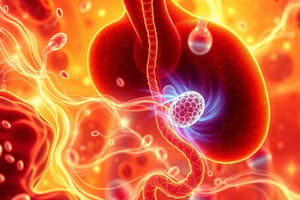Podcast
Questions and Answers
Drugs that are lipid soluble are easily excreted through the kidneys.
Drugs that are lipid soluble are easily excreted through the kidneys.
False (B)
The process of ______ involves the movement of drug molecules across the renal tubular epithelium.
The process of ______ involves the movement of drug molecules across the renal tubular epithelium.
diffusion
Which of the following is NOT a mechanism by which drug-drug interactions can affect drug excretion?
Which of the following is NOT a mechanism by which drug-drug interactions can affect drug excretion?
- Altering urine flow and/or urine pH
- Modifying drug metabolism (correct)
- Inhibiting tubular secretion
- Altering protein binding
What is the 'ion trapping effect' and how does it affect drug excretion?
What is the 'ion trapping effect' and how does it affect drug excretion?
Match the following drug classes with their effect on drug excretion:
Match the following drug classes with their effect on drug excretion:
Which of the following is a consequence of using diuretics like furosemide with drugs relying on tubular secretion for elimination?
Which of the following is a consequence of using diuretics like furosemide with drugs relying on tubular secretion for elimination?
Changes in urine pH can be a significant factor in accidental drug interactions.
Changes in urine pH can be a significant factor in accidental drug interactions.
Explain how probenecid prolongs the action of penicillin.
Explain how probenecid prolongs the action of penicillin.
What percentage of total drug in the body is accounted for by enterohepatic circulation?
What percentage of total drug in the body is accounted for by enterohepatic circulation?
Glucuronides are predominantly concentrated in the urine after excretion.
Glucuronides are predominantly concentrated in the urine after excretion.
Name a drug that is significantly excreted in the bile unchanged.
Name a drug that is significantly excreted in the bile unchanged.
In enterohepatic circulation, the liver transfers substances from plasma to the _____ via transport systems.
In enterohepatic circulation, the liver transfers substances from plasma to the _____ via transport systems.
Match the following drugs with their corresponding actions:
Match the following drugs with their corresponding actions:
What is renal clearance primarily used for?
What is renal clearance primarily used for?
Drugs like amiodarone are cleared rapidly from the kidneys.
Drugs like amiodarone are cleared rapidly from the kidneys.
What is the equation to calculate renal clearance (CLren)?
What is the equation to calculate renal clearance (CLren)?
Most drugs cross the glomerular barrier, except for macromolecules like ______.
Most drugs cross the glomerular barrier, except for macromolecules like ______.
Match the types of drugs with their corresponding clearance characteristics:
Match the types of drugs with their corresponding clearance characteristics:
Which process accounts for the majority of renal drug elimination?
Which process accounts for the majority of renal drug elimination?
Plasma albumin allows free drug molecules to be filtered into glomerular filtrate.
Plasma albumin allows free drug molecules to be filtered into glomerular filtrate.
What percentage of renal plasma flow is typically filtered through the glomerulus?
What percentage of renal plasma flow is typically filtered through the glomerulus?
Flashcards
Biliary excretion
Biliary excretion
The process of transferring substances, including drugs, from the bloodstream to bile via liver cells.
Enterohepatic circulation
Enterohepatic circulation
The recycling process where glucuronides are hydrolyzed in the intestine, releasing active drugs that can be reabsorbed.
Glucuronides
Glucuronides
Hydrophilic drug conjugates concentrated in bile, which can regenerate active drugs in the intestine.
Drug reservoir
Drug reservoir
Signup and view all the flashcards
Examples of biliary excretion
Examples of biliary excretion
Signup and view all the flashcards
Renal tubular secretion
Renal tubular secretion
Signup and view all the flashcards
Passive reabsorption
Passive reabsorption
Signup and view all the flashcards
Lipid soluble drugs
Lipid soluble drugs
Signup and view all the flashcards
Polar drugs
Polar drugs
Signup and view all the flashcards
Ion trapping
Ion trapping
Signup and view all the flashcards
Probenecid
Probenecid
Signup and view all the flashcards
Diuretics and drug excretion
Diuretics and drug excretion
Signup and view all the flashcards
Urinary pH effects
Urinary pH effects
Signup and view all the flashcards
Renal clearance
Renal clearance
Signup and view all the flashcards
CLren equation
CLren equation
Signup and view all the flashcards
Glomerular filtration
Glomerular filtration
Signup and view all the flashcards
Plasma albumin
Plasma albumin
Signup and view all the flashcards
Tubular secretion
Tubular secretion
Signup and view all the flashcards
OAT and OCT
OAT and OCT
Signup and view all the flashcards
Competition for transport
Competition for transport
Signup and view all the flashcards
Rapid elimination of penicillin
Rapid elimination of penicillin
Signup and view all the flashcards
Study Notes
Drug Excretion
- Liver cells use transport systems (OCTs, OATS, P-gps) to transfer substances, including drugs from plasma to bile.
- Hydrophilic drug conjugates (particularly glucuronides) are concentrated in the bile and delivered to the intestine.
- In the intestine, glucuronides can be hydrolyzed, regenerating the active drug, which can be reabsorbed. This is called enterohepatic circulation.
- Enterohepatic circulation creates a drug reservoir, increasing duration of action and accounting for about 20% of total drug in the body.
- Examples of drugs involved in enterohepatic circulation include morphine and ethinylestradiol.
- Some drugs, like vecuronium, are mainly excreted unchanged in the bile.
- Rifampicin is absorbed from the gut, deacetylated, and secreted into the bile. The deacetylated form is not reabsorbed, leading to its excretion in feces.
Renal Clearance
- Renal clearance quantifies the elimination of drugs by the kidneys.
- It's defined as the volume of plasma containing the amount of drug removed from the body by the kidneys in a unit of time.
- Calculated using the formula: CLren = (Cu x Vu)/Cp where:
- CLren = Renal clearance
- Cu = Urinary concentration
- Vu = Urine flow rate
- Cp = Plasma concentration
- Fundamental processes for renal drug excretion: glomerular filtration, active tubular secretion, and passive reabsorption.
- Drugs differ in their clearance rates. Some are cleared almost completely on a single pass through the kidney (e.g., penicillin, PAH), while others are cleared more slowly (e.g., amiodarone, risedronate).
Glomerular Filtration
- Glomerular capillaries allow drug molecules with a molecular weight (MW) of about 20 kDa to pass into the glomerular filtrate.
- Plasma albumin (MW 68 kDa) is impermeable to the glomerular barrier.
- Most drugs (except large molecules like heparin) freely cross the glomerular barrier.
- If a drug binds to plasma albumin, only the free drug is filtered into the glomerular filtrate.
- Drugs like warfarin, which are highly bound to albumin (approx. 98%), have a reduced concentration in the filtrate (only about 2% of plasma concentration). This leads to reduced clearance by filtration.
Tubular Secretion
- Approximately 20% of renal plasma flow is filtered through the glomerulus, leaving most of the drug to reach peritubular capillaries of the proximal convoluted tubule (PCT).
- In the PCT, drug molecules are transferred to the tubular lumen via two independent, non-selective carrier systems: OATs and OCTs.
- OATs transport acidic drugs (negatively charged anionic form), whereas OCTs transport organic bases (protonated cationic form).
- Tubular secretion is a very efficient mechanism for renal drug elimination, even when the drug is highly protein bound.
- Drugs like penicillin are cleared rapidly by tubular secretion, even though they are largely protein bound.
- Many drugs compete for the same transport systems in the tubules, leading to potential drug interactions. Probenecid inhibits the tubular secretion of other drugs, like penicillin and zidovudine.
Diffusion Across Renal Tubular Epithelium
- Water is reabsorbed as fluid passes through the renal tubules.
- If a drug molecule is permeable to the tubule, approximately 99% of the filtered drug will be reabsorbed passively down the concentration gradient.
- Lipid-soluble drugs are poorly excreted; polar drugs of low tubular permeability remain in the lumen as water is reabsorbed.
- Drugs like digoxin and aminoglycoside antibiotics are not metabolized, their renal excretion is crucial to their duration of action.
- Drug excretion is impacted by factors such as body pH levels and the degree of ionization.
- This makes adjustments to drug dosage necessary when considering factors such as age and renal disease.
Drug-Drug Interactions Affecting Excretion
- Drug interactions can affect drug excretion through several mechanisms:
- Altering protein binding, impacting filtration rates.
- Inhibiting tubular secretion.
- Altering urine flow and/or urine pH.
Inhibition of Tubular Secretion
- Probenecid was initially developed to inhibit the secretion of penicillin, extending its duration of action.
- Probenecid also inhibits the excretion of other drugs, like zidovudine.
- Some drugs have unintended effects, such as enhancing the actions of substances relying on tubular secretion for elimination. Examples include diuretics like furosemide, whose effects may be reduced by drugs inhibiting their tubular secretion (e.g., NSAIDs).
Alteration of Urine Flow and pH
- Diuretics generally increase the urinary excretion of other drugs and their metabolites.
- Loop and thiazide diuretics can indirectly decrease the excretion of lithium by reducing sodium reabsorption; this can lead to increased lithium levels in the body, potentially causing toxicity.
- Lithium carbonate use with diuretics is a potential issue requiring consideration.
- Urinary pH affects the excretion of weak acids and bases. This can be used medically to treat conditions like salicylate poisoning.
Studying That Suits You
Use AI to generate personalized quizzes and flashcards to suit your learning preferences.




